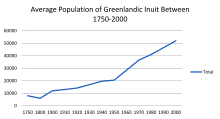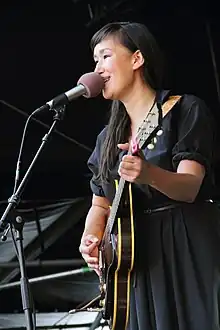Greenlandic Inuit
The Greenlandic Inuit (Greenlandic: kalaallit, Danish: Grønlandsk Inuit) are the indigenous and most populous ethnic group in Greenland.[12] Most speak Greenlandic (Western Greenlandic, Kalaallisut) and consider themselves ethnically Greenlandic. People of Greenland are citizens of Denmark.
| Total population | |
|---|---|
| c. 70,000 | |
| Regions with significant populations | |
| Greenland | 51,349[1] |
| Denmark | 16,470[2] |
| United States | 352[3] |
| Norway | 293[4] |
| Faroe Islands | 163[5] |
| Iceland | 65[6] |
| Canada | 55[7] |
| Netherlands | 14[8] |
| Languages | |
| Greenlandic[9][10] West Greenlandic Pidgin (extinct) | |
| Religion | |
| Predominantly Lutheran (Church of Denmark)[9] Minority Inuit religion See Religion in Greenland | |
| Related ethnic groups | |
| other Inuit people | |

Approximately 89 percent of Greenland's population of 57,695 is Greenlandic Inuit, or 51,349 people as of 2012.[9] Ethnographically, they consist of three major groups:
- the Kalaallit of west Greenland, who speak Kalaallisut
- the Tunumiit of Tunu (east Greenland), who speak Tunumiit oraasiat ("East Greenlandic")
- the Inughuit of north Greenland, who speak Inuktun ("Polar Eskimo")
Historically, Kalaallit referred specifically to the people of Western Greenland. Northern Greenlanders call themselves Avanersuarmiut or Inughuit, and Eastern Greenlanders call themselves Tunumiit, respectively.[13]
Today, most Greenlanders are bilingual speakers of Kalaallisut and Danish and most trace their lineage to the first Inuit that came to Greenland. The vast majority of ethnic Greenlanders reside in Greenland or elsewhere in the Danish Realm, primarily Denmark proper (approximately 20,000 Greenlanders reside in Denmark proper). A small minority reside in other countries, mostly elsewhere in Scandinavia and North America. There are though a number of Greenlanders and Greenlandic families whom today are multiracial, mostly due to marriages between Greenlanders and Danish colonists as well as other Europeans.
Regions
The Inuit are descended from the Thule people, who settled Greenland in between AD 1200 and 1400. As 84 percent of Greenland's land mass is covered by the Greenland ice sheet, Inuit people live in three regions: Polar, Eastern, and Western. In the 1850s, additional Canadian Inuit joined the Polar Inuit communities.[14]
The Eastern Inuit, or Tunumiit, live in the area with the mildest climate, a territory called Tunu or Tasiilaq. Hunters can hunt marine mammals from kayaks throughout the year.[14]
Language


Kalaallisut is the official language of Greenland.[9] It is the western variety of the Greenlandic language, which is one of the Inuit languages within the Eskimo-Aleut family.[10] Kalaallisut is taught in schools and used widely in Greenlandic media.
History
.jpg.webp)
The first people arrived in Greenland from the Canadian island of Ellesmere, around 2500 to 2000 BCE, from where they colonized north Greenland as the Independence I culture and south Greenland as the Saqqaq culture.[15] The Early Dorset replaced these early Greenlanders around 700 BCE, and themselves lived on the island until c. 1 CE.[15] These people were unrelated to the Inuit.[15] Save for a Late Dorset recolonisation of northeast Greenland c. 700 CE, the island was then uninhabited until the Norse arrived in the 980s. Between 1000 and 1400, the Thule, ancestors of the Inuit,[16][17] replaced the Dorset in Arctic Canada, and then moved into Greenland from the north.[18] The Norse disappeared from southern Greenland in the 15th century, and although Scandinavians revisited the island in the 16th and 17th centuries, they did not resettle until 1721. In 1814, the Treaty of Kiel awarded Greenland to Denmark.
The primary method of survival for the Thule was hunting seal, narwhal, and walrus as well as gathering local plant material.[17][19][18] Archaeological evidence of animal remains suggests that the Thule were well adjusted to Greenland and in such a way that they could afford to leave potential sources of fat behind.[19]
European visitors to Northeast Greenland before the early 19th century reported evidence of extensive Inuit settlement in the region although they encountered no humans. In 1823, Douglas Charles Clavering met a group of twelve Inuit in Clavering Island. Later expeditions, starting with the Second German North Polar Expedition in 1869, found the remains of many former settlements, but the population had apparently died out during the intervening years.
In 1979, the Greenlanders voted to become autonomous. There is an active independence movement.
The population of Greenlandic Inuit has fluctuated over the years. A smallpox outbreak reduced the population from 8,000 to 6,000 in the 18th century.[20] The population doubled in 1900 to 12,000 then steadily rose by around 100 people each year from 1883–1919.[20] Tuberculosis caused a drop in the population, but after several decades of steady birth rates and commercial fishing over traditional hunting, the population reached 41,000 in 1980.[20]
Society
Gender roles among Greenlandic Inuit are flexible; however, historically men hunted and women prepared the meat and skins. Most marriages are by choice, as opposed to arranged, and monogamy is commonplace. Extended families are important to Inuit society.
Greenland Inuit diet consists of a combination of local or traditional dishes and imported foods, with the majority of Inuit, aged 18 to 25 and 60 and older, preferring customary, local foods like whale skin and dried cod over imported foods like sausage or chicken.[21] That study also reveals that those who grew up in villages only consumed local, Inuit cuisine foods 31 times a month and those who lived in Danish areas would consume local, Inuit cuisine 17 times per month.[21] The reasons for the lack of traditional food consumption varies, but 48 percent of respondents claim that they wanted to have variety in their diet, 45 percent of respondents said it was difficult to obtain traditional foods, and 39 percent said that traditional foods were too expensive.[21]
The kinds of whale that have been historically hunted and consumed are the Minke and Fin whales, both are under watch by the International Whaling Commission (IWC).[22][23] Greenland Home Rule implemented IWC quotas on aboriginal whale hunting, reducing hunting of Minke whales to a maximum of 115 per year and Fin whales to 21 per year.[22]
Art
The Greenlandic Inuit have a strong artistic practice based on sewing animal skins (skin-sewing) and making masks. They are also known for an art form of figures called tupilait or "evil spirit objects". Sperm whale ivory (teeth) remains a valued medium for carving.[24]
Customary art-making practices thrive in Ammassalik Island.[25] Ammassalik wooden maps are carved maps of the Greenlandic coastline, used in the late 19th century.
See also
Notes
- "Grønlands Statistik". Stat.gl. Retrieved 2015-10-25.
- "Statistikbanken". Statistics Denmark. 2018. Retrieved July 22, 2018.
- "Table 1. First, Second, and Total Responses to the Ancestry Question by Detailed Ancestry Code: 2000". U.S. Census Bureau. Retrieved 2013-05-05.
- "Foreign born, by sex and country background". Statistisk centralbyrå - Statistics Norway. Retrieved 2016-07-03.
- "IB01040 Population by birth country, sex and age, 1th January (1985-2016)". Hagstova Føroya - Statistics Faroe Islands. Retrieved 2016-07-03.
- "Population by country of birth, sex and age 1 January 1998-2015". Hagstofa Íslands - Statistics Iceland. Retrieved 2016-07-03.
- "Immigrant population by place of birth, period of immigration, 2016 counts, both sexes, age (total), Canada, 2016 Census". Statistics Canada. 2017-10-25. Retrieved 2018-07-22.
- "Population; sex, age, migration background and generation, 1 January". Statistics Netherlands (CBS). Retrieved 2018-07-22.
- "Greenland." CIA World Factbook. Retrieved 6 Aug 2012.
- "Inuktitut, Greenlandic." Ethnologue. Retrieved 6 Aug 2012.
- Lawrence C. Hamilton and Rasmus Ole Rasmussen, "Population, Sex Ratios and Development in Greenland", Arctic 63, no. 1 (2010): 43–52.
- Indigenous peoples in Greenland at the International Work Group for Indigenous Affairs
- Baldacchino, Geoffery. "Extreme tourism: lessons from the world's cold water islands", Elsevier Science, 2006: 101. (retrieved through Google Books) ISBN 978-0-08-044656-1.
- Hessel 11
- d'Andrea, William J.; Huang, Yongsong; Fritz, Sherilyn C.; Anderson, N. John (2011). "Abrupt Holocene climate change as an important factor for human migration in West Greenland". Proceedings of the National Academy of Sciences of the United States of America. 108 (24): 9765–9769. Bibcode:2011PNAS..108.9765D. doi:10.1073/pnas.1101708108. JSTOR 25831309. PMC 3116382. PMID 21628586.
- D'Andrea, William J.; Huang, Yongsong; Fritz, Sherilyn C.; Anderson, N. John (2011). "Abrupt Holocene climate change as an important factor for human migration in West Greenland". Proceedings of the National Academy of Sciences of the United States of America. 108 (24): 9765–9769. Bibcode:2011PNAS..108.9765D. doi:10.1073/pnas.1101708108. JSTOR 25831309. PMC 3116382. PMID 21628586.
- Lynnerup, Niels (2015). "The Thule Inuit Mummies From Greenland". The Anatomical Record. 298 (6): 1001–1006. doi:10.1002/ar.23131. PMID 25998634.
- Sørensen, Mikkel; Gulløv, Hans Christian (2012). "The Prehistory of Inuit in Northeast Greenland". Arctic Anthropology. 49 (1): 88–104. doi:10.1353/arc.2012.0016. JSTOR 24475839.
- Outram, Alan K. (1999). "A Comparison of Paleo-Eskimo and Medieval Norse Bone Fat Exploitation in Western Greenland" (PDF). Arctic Anthropology. 36 (1/2): 103–117. JSTOR 40316508.

- Hamilton, Lawrence C.; Rasmussen, Rasmus Ole (2010). "Population, Sex Ratios and Development in Greenland". Arctic. 63 (1): 43–52. doi:10.14430/arctic645. JSTOR 40513368.
- Pars, Tine; Osler, Merete; Bjerregaard, Peter (2001). "Contemporary Use of Traditional and Imported Food among Greenlandic Inuit". Arctic. 54 (1): 22–31. doi:10.14430/arctic760. JSTOR 40512274.
- Caulfield, Richard A. (1993). "Aboriginal Subsistence Whaling in Greenland: The Case of Qeqertarsuaq Municipality in West Greenland". Arctic. 46 (2): 144–155. doi:10.14430/arctic1336. JSTOR 40511506. S2CID 53512929.
- "Population Estimates". iwc.int. Retrieved 2018-03-17.
- Hessel 21
- Ingo 20
References
- Hessel, Ingo (2006). Arctic Spirit. Vancouver: Douglas and McIntyre. ISBN 978-1-55365-189-5.

.svg.png.webp)
